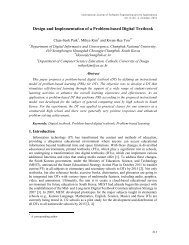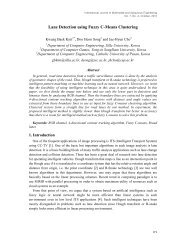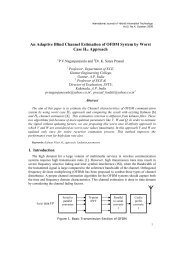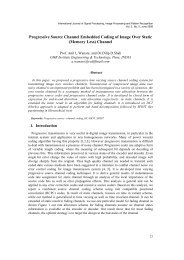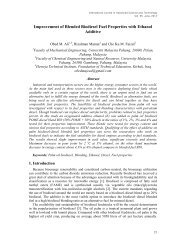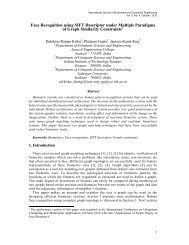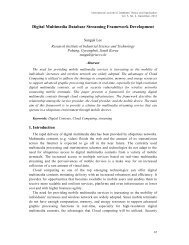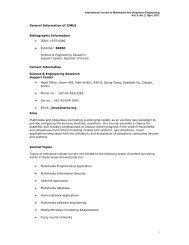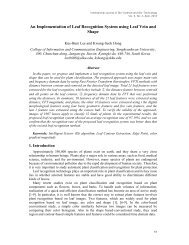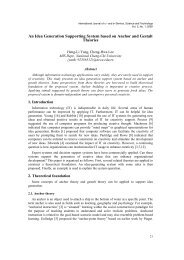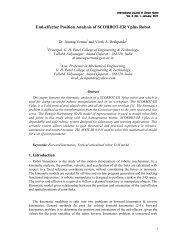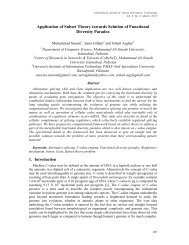A Communication Protocol of RFID Systems in Internet of Things
A Communication Protocol of RFID Systems in Internet of Things
A Communication Protocol of RFID Systems in Internet of Things
You also want an ePaper? Increase the reach of your titles
YUMPU automatically turns print PDFs into web optimized ePapers that Google loves.
International Journal <strong>of</strong> Security and Its Applications<br />
Vol. 6, No. 2, April, 2012<br />
Random Oracle model [10] is applied to describe the <strong>RFID</strong> system model <strong>in</strong> <strong>in</strong>ternet<br />
<strong>of</strong> th<strong>in</strong>gs. The model can be equivalent to a tuple P ( )<br />
, and are time<br />
functions <strong>of</strong> polynomial whose safety factor is 1 k ( k<br />
N)<br />
, def<strong>in</strong>es the behavior <strong>of</strong> a<br />
legitimate reader, def<strong>in</strong>es the operation <strong>of</strong> a legitimate tag. Us<strong>in</strong>g the random Oracle to<br />
query and def<strong>in</strong>ite the behavior <strong>of</strong> an attacker, that is, the attacker which has Oracle<br />
s<br />
s<br />
<br />
R i,T<br />
( R<br />
j i<br />
<strong>in</strong>itiates a session s with T j<br />
) and Oracle <br />
Tj,R<br />
( T<br />
i j<br />
<strong>in</strong>itiates a session s<br />
with R i<br />
)is an Oracle probability mach<strong>in</strong>e. The attacker can achieve the attack target by<br />
s<br />
s<br />
send<strong>in</strong>g scheduled questions to Oracle R i,T<br />
and Oracle <br />
j<br />
Tj,R<br />
and receiv<strong>in</strong>g response<br />
i<br />
<strong>in</strong>formation from the random Oracle. Oracle question depicts the real ability <strong>of</strong> the<br />
attacker. The attacker can send the follow<strong>in</strong>g questions.<br />
Execute ( R <br />
T<br />
, P)<br />
: the question depicts an <strong>in</strong>stance P that the attacker execute the<br />
i j<br />
protocol between T j<br />
and R i<br />
which can obta<strong>in</strong> all messages exchanged between the<br />
reader and the tag when the protocol P executes.<br />
SendTag ( <br />
T<br />
, Pm ,<br />
1)<br />
: the question depicts an <strong>in</strong>stance P that the attacker A sends the<br />
j<br />
message m<br />
1<br />
to tag T j<br />
, and receives the response message <strong>of</strong> the tag T j<br />
.<br />
SendReader ( <br />
R<br />
, Pm ,<br />
2)<br />
:the question depicts <strong>in</strong>stance P that the attacker A sends the<br />
i<br />
message m2<br />
to reader R i<br />
, and receives the response message <strong>of</strong> the reader R i<br />
.<br />
CorruptTag ( ):the question depicts an active attack on the tag and the attacker's<br />
Tj<br />
captured capacity. It can make the captured tag T j<br />
actively reveal secret <strong>in</strong>formation<br />
which is <strong>in</strong> their private storage space.<br />
CorruptRead ( ):the question depicts an active attack on the reader and the attacker's<br />
Ri<br />
captured capacity. It can make the captured reader R i<br />
actively reveal secret <strong>in</strong>formation which<br />
is <strong>in</strong> their private storage space.<br />
Test ( ):the question is used to test semantic security <strong>of</strong> confidential <strong>in</strong>formation <strong>of</strong> a tag<br />
Tj<br />
T j<br />
. By throw<strong>in</strong>g co<strong>in</strong> b , if b = 1, return the secret <strong>in</strong>formation stored <strong>in</strong> the tag. if b = 0,<br />
return an random number which is equivalent <strong>in</strong> length to the secret <strong>in</strong>formation <strong>of</strong> the tag.<br />
Test ( ):the question is used to test semantic security <strong>of</strong> confidential <strong>in</strong>formation <strong>of</strong><br />
Ri<br />
a reader R i<br />
.By throw<strong>in</strong>g co<strong>in</strong> b , if b = 1, return the secret <strong>in</strong>formation stored <strong>in</strong> the<br />
tag. if b = 0, return an random number which is equivalent <strong>in</strong> length to the secret<br />
<strong>in</strong>formation <strong>of</strong> the reader.<br />
3.2 Security Requirements <strong>of</strong> Authentication <strong>in</strong> <strong>RFID</strong> System <strong>of</strong> <strong>Internet</strong> <strong>of</strong> Th<strong>in</strong>gs<br />
An <strong>RFID</strong> system is an important part <strong>of</strong> <strong>in</strong>ternet <strong>of</strong> th<strong>in</strong>gs, non-contact automatic<br />
identification technology between the reader and the tag <strong>in</strong> the system which makes the<br />
system face serious security problems. Analyz<strong>in</strong>g the security needs met by exist<strong>in</strong>g typical<br />
<strong>RFID</strong> protocols and comb<strong>in</strong><strong>in</strong>g the characteristics <strong>of</strong> <strong>RFID</strong> system <strong>of</strong> <strong>in</strong>ternet <strong>of</strong> th<strong>in</strong>gs, what<br />
needs the authentication should meet <strong>in</strong> <strong>RFID</strong> system <strong>of</strong> <strong>in</strong>ternet <strong>of</strong> th<strong>in</strong>gs are detailed <strong>in</strong> the<br />
follow<strong>in</strong>g.<br />
93



